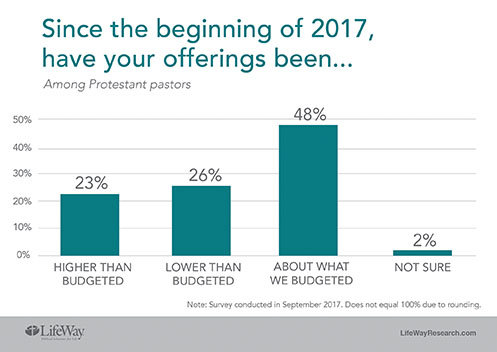 By Bob Smietana
By Bob Smietana
NASHVILLE, TN — Church collection plates were a little bit fuller last fall, according to Nashville-based LifeWay Research.
About 40 percent of Protestant pastors say their churches received more offerings in 2017 than in 2016.
Three-quarters say their church met or exceeded budget.
And only about a third say the economy gave their church trouble.
Those are among the findings of a new report from LifeWay Research, based on a survey of 1,000 Protestant senior pastors. LifeWay Research has tracked the impact of the economy on churches since 2009, said Scott McConnell, executive director, and this is the first time the majority of pastors said the economy isn’t troubling their church.
“The past decade has been difficult for many church budgets,” said McConnell. “But things seem to be looking up.”
At the height of the Great Recession in 2010, LifeWay Research found most pastors (80 percent) said the economy had a negative effect on the church budget. That dropped to 51 percent by March 2016.
In the most recent survey – from the fall of 2017 – 35 percent of pastors say the economy has a negative impact on the church. Seventeen percent cite a positive impact, and 45 percent say no impact.
African-American pastors (59 percent) and pastors of churches with 50 to 99 attenders (40 percent) are more likely to say the economy is having a negative impact. Pastors of larger churches (with 250 or more attenders) are more likely to say the economy is treating their church well (28 percent).
Mainline pastors (41 percent) see more negative impact than evangelical pastors (32 percent). Lutherans (44 percent) see more negative impact than Baptists (31 percent).
Pentecostal pastors (25 percent) see more positive impact than Baptist (15 percent) or Presbyterian/Reformed pastors (13 percent).
About half of pastors (48 percent) say they are meeting their budget. Twenty-three percent say offerings are higher than budgeted. Twenty-six percent say offerings are lower.
 Larger churches – with 250 or more attenders – are more likely to say offerings are higher (30 percent). Pastors of smaller churches – with fewer than 100 attenders – are more likely to say offerings are lower (29 percent).
Larger churches – with 250 or more attenders – are more likely to say offerings are higher (30 percent). Pastors of smaller churches – with fewer than 100 attenders – are more likely to say offerings are lower (29 percent).
African-American pastors (41 percent) are more likely to say giving is under budget than white pastors (26 percent).
More Baptist (27 percent), Pentecostal (30 percent), and Presbyterian/Reformed pastors (23 percent) say offerings are over budget than Methodists (12 percent).
Baptist (30 percent), Methodist (34 percent), and Holiness pastors (34 percent) are more likely to report budget shortfalls. Pentecostal pastors (17 percent) are less likely.
Overall, most pastors (78 percent) say offerings held steady from the previous year. Forty percent say offerings went up. Eighteen percent say they went down. Thirty-eight percent say offerings stayed the same.
Some churches of all sizes saw an increase from 2016. That includes about half (47 percent) of churches with 100 to 249 attenders and 57 percent of churches with 250 or more attenders. Smaller churches fared a bit less well. Twenty-six percent of churches with fewer than 50 attenders saw an increase. Thirty-five percent of churches with 50 to 99 attenders said giving is up.
Pastors in the North, South, and West had a better year than those in the Midwest. Forty-two percent of pastors in those regions say giving was up. Only 34 percent of pastors in the Midwest say it increased.
More Baptist (45 percent) and Pentecostal (46 percent) pastors saw giving go up than Methodists (28 percent).
Few pastors saw major growth or decline in giving. One in 5 pastors say their church giving was up by less than 10 percent. Only 4 percent say their church offerings were up by 25 percent. One in 10 pastors (9 percent) say giving dropped by 10 to 24 percent. Two percent of pastors saw a 25 percent decline.
Still, churches seem to be regaining their footing as the economy improves, McConnell said.
“Overall, 2017 was a good year for church budgets,” he said. “Except for isolated local downturns, the financial struggles of churches not meeting budget likely have nothing to do with the overall economy.”
Bob Smietana is senior writer for Facts & Trends. This post originally appeared at LifeWay Research.